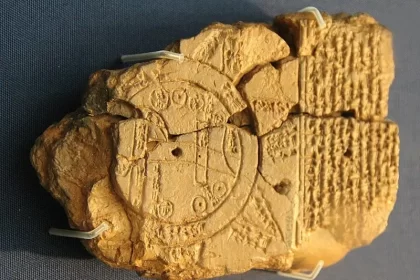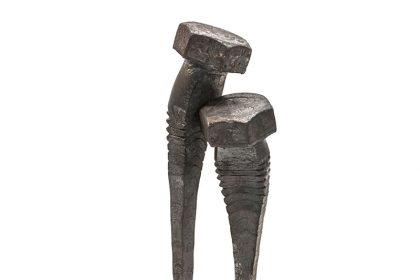September 12, 1402 at 10:39
New research reports the extinction of 99% of human ancestors, and based on that, humans may have been pushed to the brink of extinction millions of years ago.
The exact paths of human evolution are still unclear, but a new paper opens uncharted paths for researchers. According to this new discovery, it seems that human ancestors were pushed to the brink of extinction after ancient population declines.
Evidence suggests that modern humans evolved over the past 200,000 years and spread across Africa from about 60,000 years ago. But before that, there were events that surprised the researchers.
Read more:
The danger of extinction is lurking in humans; With artificial intelligence or nuclear bomb?
We are still unsure and debating which ancestral population may have given rise to our ancestry. About 600,000 years ago, this lineage split from Neanderthals and Denisovans, and both of these lineages intermingled with modern humans after leaving Africa.
We have survived a mass extinction!

The new study argues that there was another complex event in the human past; A period that caused the extinction of 99% of human ancestors and took the human population to the brink of destruction.
993,000 years ago, early humans faced a strange crisis due to the beginning of a kind of ice age on Earth. As the population decreased to 1280 people, the human society at that time faced a great threat and this caused the extinction of 99% of human ancestors. The remaining people continued the human race for 117 thousand years.
It is estimated that during that period Neanderthals and Denisovans lived together. The main reason for human extinction can be related to climate change, long-term drought and decrease in sea surface temperature.
The senior researcher of this study, whose name is Yi Hsuan Pan, said:
The new findings show a new way to uncover the truth about human evolution. In addition, it causes new questions in the mind; Questions like: Where did these people live? How did they overcome catastrophic climate change? Did being in this bottleneck affect the speed of human evolution? These questions need a logical answer.
However, this discovery is based on an entirely new approach to analyzing modern genomes, so it can be difficult to validate.
How did the researchers reach this conclusion?

In order to understand how researchers worked to discover the possibility that 99% of human ancestors went extinct 930,000 years ago, let’s take a look at some genetic facts. If a population is small and not inbred, genetic diversity will occur between its individuals and a set of differences will be seen in this population. These differences are tracked when tests identify your likely ancestors.
Some genetic differences arose recently, while others predate our lineage even before modern humans existed. These differences form the basis of new research work that analyzes multiple human genomes based on several well-established principles.
The first is that, given enough genomes, the ancestral state of chromosomes can be determined. For example, a change that exists only in a closely related set of individuals probably arose in their common ancestor. This means that the ancestral state of the chromosome lacks variation.
Since we know the rate of new mutations in humans today, we can use these differences to create a molecular clock. In other words, we can take the number of mutations between the current and ancestral state, compare it to the mutation rate, and estimate when that ancestral state last existed in the population.

The number of variations in a population is related to the size of the population. Smaller populations tend to inbreed; Because it becomes difficult to avoid mating with relatives and this leads to the loss of genetic diversity. In addition, there are fewer chromosomes in small populations, which limits the potential for diversity.
The reverse of this issue is also true; Because large populations can support greater diversity. Putting these findings together, you get an overview of what the researchers did to reach this conclusion.
The researchers picked out changes in modern genomes and used them to determine the existence of different ancestral states and when they likely existed. By determining how many different ancestral states existed at a given time, researchers can also estimate population size.
Is it possible to speak with certainty about the extinction of 99% of human ancestors?

This new study was published in the journal Science on August 31st, and delving into it will change our understanding of early human history. But it must be said that the principle of this study is based on probabilities, and the results for each individual chromosome bit have a relatively high chance of being wrong.
To reach this result, researchers used an advanced technique called FitCoal and genome sequences of modern humans. Now the main question is to what extent the algorithm invented by the researchers of this study can prevent existing errors.
To achieve the results of this study, scientists from East China Normal University created a model that is capable of studying modern gene lineages and can use the information obtained to estimate population size.
Various algorithms, including FitCoal (Infinitely Small Fast Fusion Process), have been designed to work on the data. FitCoal produced estimates for population size that were difficult to distinguish from the model population in most cases.
Most other algorithms produced similar results to FitCoal, although their error margins were significantly larger. The accuracy of the algorithm is the most controversial aspect of this work, and if it detects an error in the code, we probably have to rely on comparisons with other models.
Read more:
The oldest human grave in the world complicates the story of human evolution
This type of algorithm is very computationally expensive. Adding more genomes to the analysis can also provide some transparency, as the results become more accurate with more data. But additional genomes worsen the computational challenge.
After developing this algorithm, the scientists analyzed the DNA of about 3,000 modern humans from both African and non-African populations. Non-African populations represent relatively stable individuals who experienced rapid growth as their ancestors migrated out of Africa. But African populations showed a massive decline in population size that began about 930,000 years ago and continued for more than 100,000 years.

During this time, the effective population size (individuals contributing to population maintenance) was only about 1,300. It is this small number that makes the idea of the extinction of 99% of human ancestors reasonable. Today, we list a population of this number on the endangered species list.
Tracking further diversity leads scientists to estimate that 98.7% of our ancestral population was wiped out in a sudden collapse. This event was what is called a constriction, as the entire population passed through a sudden, narrow contraction. Out-of-Africa population expansion, which created its own bottleneck, interferes with our ability to detect earlier events, the researchers say.
The researchers noted that the catastrophe happened around the same time as the climate system changed from relatively short and moderate ice ages to longer, colder ones.

Two other notable events in this period can be considered as bottlenecks. One is that two chromosomes found in chimpanzees and other apes have fused to form one larger chromosome in the human lineage. It is estimated that this happened around this time. A small population allows this chromosome to spread more easily throughout our entire lineage.
The second is that molecular evidence suggests that Neanderthals and Denisovans diverged from our lineage shortly after the bottleneck. The release of any environmental pressures that kept populations small would have allowed some of our ancestors to expand into new habitats and form distinct populations.
So the idea of a bottleneck in human ancestral time is compelling, but it needs evidence beyond the output of an algorithm before it can be widely accepted. Fortunately, there are many ways to get at this evidence, from fossil discoveries to genome sequencing and algorithm development. So it will soon be proven whether the idea of the extinction of 99% of human ancestors in the past thousands of years is true or just a false conclusion.
RCO NEWS
















